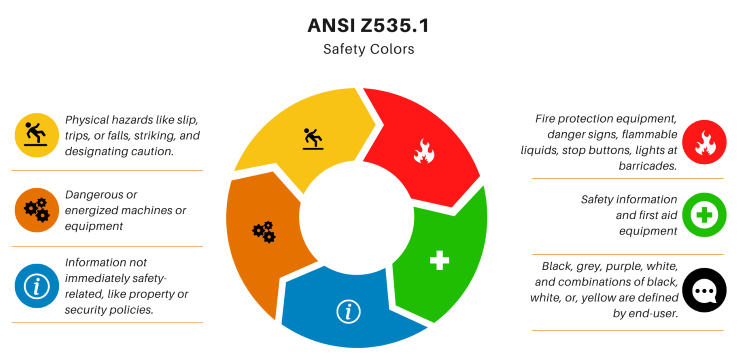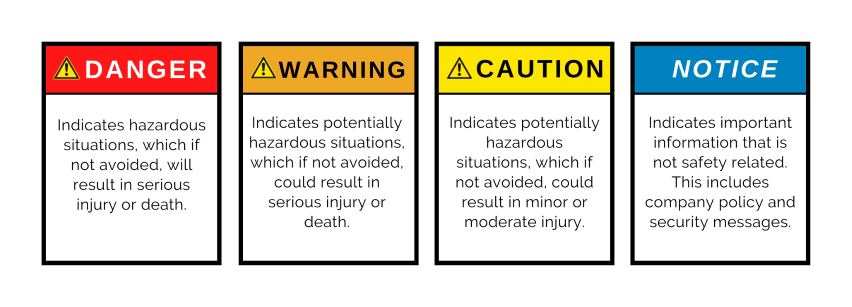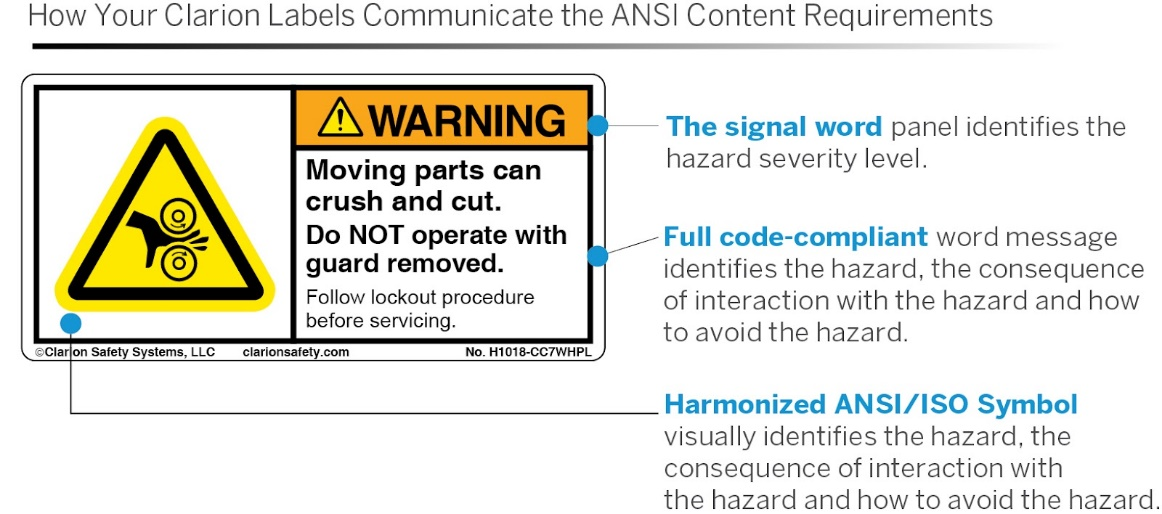
The Purpose of the ANSI Standards
ANSI is the American National Standards Institute. It is a private organization involved with coordinating and publishing voluntary consensus standards that are used for nearly every product, process, and system in the U.S. In addition to publishing ANSI standards in the U.S., ANSI is also involved in coordinating U.S. standards with international standards, like ISO so that products can be used worldwide. The goal is to have products with consistent characteristics and performance, and terminology with consistent definitions. That way, consumers can have confidence in their products, and those products will meet functionality expectations.
Download Our Free ANSI Z535.4 Factsheet
The Importance of the ANSI Z535 Standards
As ANSI is not a government agency, the standards they publish are not always backed by the force of law. That’s why these are called voluntary standards. However, some ANSI standards are referenced by enforceable codes and standards set by government agencies like OSHA. It’s important to note that OSHA doesn’t always reference the most current ANSI standard, as the OSHA approval process takes a longer time to develop than other non-governmental agencies. However, you must comply with the specific version of the ANSI standard that is referenced by OSHA. For product manufacturers, the Z535 committee of ANSI is responsible for on-product labeling best practices and is important for compliance. It also details signage requirements for production facilities.
As stated by ANSI, the basic mission and fundamental purpose of the ANSI Z535 Committee is to develop, refine, and promote a single, uniform graphic system used for presenting safety and accident prevention information. This approach helps standard users to efficiently develop product safety signs and labels, and assists sign viewers in recognizing symbols as being related to safety. The ANSI Z535 family of standards is on a five-year revision cycle to ensure the standard stays relevant and up-to-date. 2022 marks the first time many of the standards in the ANSI Z535 family – including ANSI Z535.4 – have been reviewed and updated in more than 10 years. In 2017, the prior 2011 version of ANSI Z535 was reaffirmed or republished without changes. The family of six sub standards, soon to be seven - all work together and have specific roles, as are defined throughout this article.
What is ANSI Z535.1?
ANSI Z535.1 Safety Colors is a standard that describes the color codes that can be used on accident prevention signs, labels, and tags. Using ANSI Z535.1 color codes helps to create a unified look for these hazards and equipment, which can help in increasing a worker’s recognition of them and increase the necessary reaction time to hazards or emergencies. ANSI Z535.1 color codes are set for nine colors and their combinations, specific printing colors and details can be found within the standard itself. The usages for each color are as follows in the graphic below:

This standard is used across the board in safety materials as it unifies all of the safety colors. Here at Clarion Safety, our head of standards compliance, Angela Lambert, is the chair of this subcommittee.
What are ANSI Z535.2 Requirements?
ANSI Z535.2 Environmental and Facility Safety Signs regulates requirements for the design, application, and use of safety signs in facilities and in the environment through a consistent visual layout. It also includes details for sign legends, which should be concise messages that accurately describe the hazard or policy that the sign is indicating. When possible, the sign legend should include the type of hazard, the consequence of not avoiding it, and directions for how to avoid the hazard.
Each header and signal word combination is classified by the seriousness of the potential hazard that it indicates. The four main ones are: Danger, Warning, Caution, and Notice.
 What is the Criteria of ANSI Z535.3?
What is the Criteria of ANSI Z535.3?
ANSI Z535.3 Criteria for Safety Symbols provides general criteria for the design, evaluation, and use of safety symbols to identify and warn against specific hazards and information to avoid personal injury. With the ability to quickly provide important safety information across different languages, reading comprehension levels, and learning backgrounds, effective symbols are consistent in their design. This consistency often creates a familiarity with the images, making it easier to notice differences, such as the addition of a hard hat or other feature that is important to the potentially hazardous situation.
The addition of symbols to a safety sign or label helps increase understanding and it’s often a best practice to include on a label or sign. ANSI Z535.3 safety symbols are separated into four different types: hazard alerting, mandatory action, prohibition, and information. In the standard itself, the layouts for each of these vary in specific requirements, although the image below shows the general background best practice for each.

Finding the best way to harmonize different symbols together in labels and signs surrounding a piece of machinery or area can be difficult. That’s why our experts provide free personalized label and sign assessments to help with how to approach all these messages and options.
What Does ANSI Z535.4 Cover?
ANSI Z535.4 Product Safety Signs and Labels, one standard in the Z535 family, focuses specifically on product safety labels. It’s intended to establish requirements for safety symbols and labels on products intended to identify potential hazards related to it. When it comes to product safety label content, the ANSI Z535.4 standard says a hazard alerting product safety label should convey the following four content elements:
- The nature of the hazard (i.e. the type of hazard; for example, electric shock, cut, burn, etc.).
- The consequence of interaction with the hazard.
- How to avoid the hazard.
- The seriousness level of the hazard.

As shown in the illustration above, and according to these ANSI standards, the first three items of content (describing the nature of the hazard, the consequence of interaction, and how to avoid the hazard) are conveyed by the word message and/or one or more symbols. The signal word panel communicates the last item of content – hazard seriousness. For more specific information on the ANSI Z535.4 standard you can visit our article, or download the standard from the ANSI website.
What Does ANSI Z535.5 Include?
ANSI Z535.5 Safety Tags And Barricade Tapes For Temporary Hazards discusses safety tags and tapes, which are used only until the identified hazard is eliminated or the hazardous operation is completed. The safety instructions tag was added in addition to the existing types of signs, hazard alerting tags, and barricade tapes, which were more clearly defined and named in the latest edition. Industries that employ lockout/tagout (LOTO) procedures or have a need to mark an area affected by a temporary hazard will find this standard beneficial.
The standard makes sure to specify that safety tapes and barricades should not be in place of a permanent sign or label intended for hazards in normal use, operation, or maintenance. The safety tags and barricade tape classifications are sorted into DANGER, WARNING, CAUTION, NOTICE, and SAFETY INSTRUCTIONS. For safety instructions, the more specific, the better, for example, LOCKOUT PROCEDURE, or SAFE OPERATING PROCEDURES. The standard also goes into further detail to explain patterns, layout, and even border colors in relation to ANSI Z535.1.
What are ANSI Z535.6 Standards?
ANSI Z535.6 Product Safety Information in Product Manuals, Instructions and Other Collateral Materials provides updated information for manufacturers to promote the efficient development of safety messages. This includes the creation of product safety manuals, user guides, assembly instructions, employee information, and any additional collateral. The standard was created to clear up confusion on how the rest of the Z535 standards should be followed in other materials, and one of the ways it accomplishes this is by grouping safety messages into four areas:
- Supplemental directives
- Grouped safety messages
- Section safety messages
- Embedded safety messages
The implementation of this standard is often very complex, as it includes incorporating all of the ANSI Z535 standards, as well as finding a way to harmonize manuals with other standards like ISO 20607 so multiple versions do not have to be made. Generally, we recommend that any new product manuals being made after this standard was developed and updated be reviewed by a standards expert prior to publication.
An On-Going Process
The job of defining the proper content of your product's safety labels is one that is never finished. You must periodically re-evaluate your labels in light of changes to the standards, as new symbols become codified and as new safety and accident information relevant to your product comes to light. Choosing Clarion Safety as your safety label manufacturer benefits your company as we’re fully informed about standards updates through our direct involvement in several key ANSI and ISO committees.
As of August in 2022, the ANSI Z535 standards are in the midst of publication with the newest updates and information, with three of the six already released and available for download (Z535.1, Z535.3, and Z535.5). The standards Z535.2, Z535.4, and Z535.6 have yet to be published, although we have gathered from our Clarion Safety committee members that they will also be experiencing updates to include further clarifications on their usage with the other standards, along with new text, definitions, and minor modifications to their wording before the end of the year.


